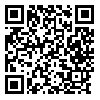شمارۀ جدید فصلنامه (پاییز1404) منتشر شد
Volume 10, Issue 2 (2-2020)
Social Problems of Iran 2020, 10(2): 217-241 |
Back to browse issues page
Download citation:
BibTeX | RIS | EndNote | Medlars | ProCite | Reference Manager | RefWorks
Send citation to:



BibTeX | RIS | EndNote | Medlars | ProCite | Reference Manager | RefWorks
Send citation to:
Karevani A, Ghafarinasab E. (2020). National Identity and Ethnic Identity in the Lifeworld of Baloch Students. Social Problems of Iran. 10(2), 217-241.
URL: http://jspi.khu.ac.ir/article-1-3172-en.html
URL: http://jspi.khu.ac.ir/article-1-3172-en.html
1- , abdollatifkarevani@yahoo.com
Abstract: (2848 Views)
The purpose of the present research is exploring qualitatively, national and ethnic identity in the lifeworld of Baloch student at state universities. In this research, grounded theory has been used as one of the qualitative research methods. The research participants were Masters and Ph.D. Baloch students at state universities. Datas are collected through in-depth interviews. Interviews continued to reach theoretical saturation in the various interviewed subjects. Data analysis was performed using open, axial, and selective coding. In the result of data analysis five categories and a core category was achieved. The categories includes: Multilayer and multiple identity resources, identity fluctuation; the movement between national and ethnic identity, the prominence of cultural components and the erosion of the political components of national identity, Representation of Balochi identity in relationship with Otherness and othering; Gajar and construction of identity frontier. The core category is othering of fluid identity. The findings also showed that the context and sources such as religious position, geographical and ethnic location along with conditions such as feeling of political discrimination, ethnic discrimination, media stereotyping, social and political status, and negative stereotypes have multiple links with the research core category.
Keywords: National identity, Ethnic identity, Identity fluctuation, Plurality of identity sources, Otherness.
Type of Article: Original Research |
Subject:
Security
Received: 2020/03/13 | Accepted: 2020/03/13 | Published: 2020/03/13
Received: 2020/03/13 | Accepted: 2020/03/13 | Published: 2020/03/13
References
1. اشتراوس، انسلم و جولیت کوربین (1391) مبانی پژوهش کیفی، فنون و مراحل تولید نظریه زمینهای، ترجمۀ ابراهیم افشار، تهران: نی.
2. امیرکافی، مهدی و ابراهیم حاجیانی (1392) «نسبت هویت قومی و ملی در جامعه چند قومیتی ایران»، فصلنامۀ راهبرد، سال بیست و دوم، شمارۀ 66: 117-146.
3. ایمان، محمد تقی (1391) روششناسی تحقیقات کیفی، قم: پژوهشگاه حوزه و دانشگاه.
4. برتون، رولان (1380) قومشناسی سیاسی، ترجمۀ ناصر فکوهی، تهران: نی.
5. برگر، پیتر، برجیت برگر و هانسفرید کلنر، هانسفرید (1381) ذهن بیخانمان؛ نوسازی و آگاهی، ترجمه محمد ساوجی، تهران: نی.
6. بشیریه، حسین (1379) جامعه شناسی سیاسی، نقش نیروهای اجتماعی درزندگی سیاسی، تهران: نی.
7. بهشتی، سیدصمد و محمد حقمرادی (1396) «فراتحلیل مطالعات مرتبط با رابطۀ بین هویت قومی و هویت ملی در ایران با تأکید بر نقش رسانه»، مسائل اجتماعی ایران، سال هشتم، شمارۀ 2: 5-27.
8. جعفرزادهپور، فروزنده و حسن حیدری (1393) «فراتحلیل رابطه هویت ملی و هویت قومی در ایران»، راهبرد اجتماعی فرهنگی، دورۀ سوم، شمارۀ 11: 63-96.
9. جنکینز، ریچارد (1385) هویت اجتماعی، ترجمۀ تورج یاراحمدی، تهران: شیرازه.
10. حسینی، سیدعباس (1395) «بررسی شکاف و زمینههای آن در لایههای فرهنگی هویت ایرانیان»، فصلنامۀ معرفت فرهنگی اجتماعی، سال هفتم، شمارۀ 4: 59-82.
11. سعید، ادوارد (1377) شرقشناسی، ترجمۀ عبدالرحیم گواهی، تهران: نشر فرهنگ اسلامی.
12. غفاری نسب، اسفندیار، ابراهیم مساوات، محمدعلی قاسمی نژاد و احمد علایی (1395) «بررسی جامعهشناختی عوامل اجتماعی و فرهنگی مؤثر بر هویت ملی»، فصلنامۀ مطالعات توسعۀ اجتماعی، دورۀ چهارم، شمارۀ 4: 9- 35.
13. قاسمی، علی اصغر، مجید خورشیدی و حسین حیدری (1390) «همسازی هویت ملی و قومی در ایران و رویکرد اقوام ایرانی به وحدت ملی و حق تعیین سرنوشت»، فصلنامۀ علوم اجتماعی، دورۀ هجدهم، شمارۀ 55: 57-99.
14. کاستلز، مانوئل (1380) عصر اطلاعات، قدرت هویت، ترجمۀ چاوشیان و خاکباز، تهران: طرح نو.
15. گیدنز، آنتونی (1394) تجدد و تشخص، ترجمۀ ناصر موفقیان، تهران: نی.
16. لهسائیزاده، عبدالعلی، علیاصغر مقدس، و مجتبی تقوینسب (1388) «بررسی عوامل داخلی مؤثر بر هویت قومی و هویت ملی در میان اعراب شهرستان اهواز»، جامعهشناسی کاربردی، سال بیستم، شمارۀ 33: 45-70.
17. مسعودنیا، حسین، راضیه مهرایی کوشکی و ناهید کیانی (1393) «بررسی رابطۀ هویت ملی و قومی»، فصلنامۀ توسعۀ اجتماعی- فرهنگی، دورۀ سوم، شمارۀ 2: 139-165.
18. هانتینگتون، ساموئل (1384) چالشهای هویـت در آمریکا، ترجمۀ محمودرضا گلشن پژوه، حسن سعیدکلاهی خیابان و عباس کاردان، تهران: مؤسسۀ فرهنگی مطالعات و تحقیقات بینالمللی ابرار معاصر.
19. Citrin, J. & Sears, D. O. (2009) “Balancing National and Ethnic Identities: The Psychology of Pluribus Unum. Measuring Identity” in R. Abdelal, Y. Herrera, A. Johnston, and R. McDermott, (Eds.), A Guide for Social Scientists: 145-175.
20. Cohen, A. P. (1996) “Personal Nationalism: A Scottish View of Some Rites, Rights, and Wrongs”, American Ethnologist, 23 (4): 802-815.
21. Gong, L. (2007) “Ethnic Identity and Identification with the Majority Group: Relations with National Identity and Self-esteem”, International Journal of Intercultural Relations, 31 (4): 503-523.
22. Hall, S. (1996) “Cultural Identity and Diaspora”, in J, Rutherford (Ed.), Identity: Community Culture, London: Lawrence &Wishart.
23. Jenkins, R. (2008) Rethinking ethnicity, London: Sage.
24. Idris, F. Hassan, Z. Ya’acob, A. Gill, S. K. & Awal, N. A. M. (2012) "The Role of Education in Shaping Youth's National Identity”, Procedia-Social and Behavioral Sciences, 59: 443-450.
25. Molina, L. E., Phillips, N. L., & Sidanius, J. (2015) “National and Ethnic Identity in the Face of Discrimination: Ethnic Minority and Majority Perspectives”, Cultural Diversity and Ethnic Minority Psychology, 21 (2): 225-236.
26. Patton, M. Q. (1980) Qualitative Research and Evaluation Methods, London: Sage.
27. Sanina, A. (2012) “Competing for a Citizen: “Visible” and “Invisible” Forms of State Identity in Russia”, Journal of Eurasian Studies, 3 (2): 126-146.
28. Stryker, S. & Burke, P. J. (2000) “The Past, Present, and Future of an Identity Theory”. Social Psychology Quarterly, 63 (4): 284-297.
29. Tajfel, H. (1982) “Social Psychology of Intergroup Relations”, Annual Review of Psychology, 33 (1): 1-39.
Send email to the article author
| Rights and permissions | |
 |
This work is licensed under a Creative Commons Attribution-NonCommercial 4.0 International License. |






